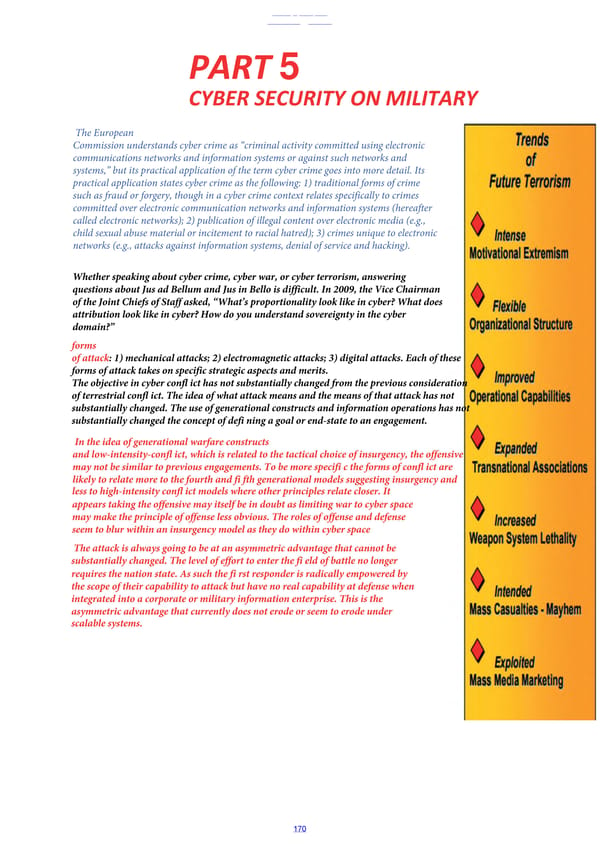PART5 CYBER SECURITY ON MILITARY The European Commission und erstands cyber crime as “criminal activity committed using elec tronic communications networks and information systems or against such networks and systems,” but its practical application of the term cyber crime goes into more detail. Its practical application states cyber crime as the following: 1) t rad itional forms of crime such as fraud or forgery, though in a cyber crime context relat es specifically to crimes committed over electronic communication networks and information systems (hereafter called electronic networks); 2) publication of illegal content over electronic media (e.g., child sexual abuse material or incitement to racial hatred); 3) crimes unique to electronic networks (e.g., attacks against information systems, denial of service and hacking). Whether speaking about cyber crime, cyber war, or cyber terrorism, answering U.S. NATIONAL CYBER STRATEGY: questions about Jus ad Bellum and Jus in Bello is difficult. In 2009, the Vice Chairman 4 PIL S of the Joint Chiefs of Staff asked, “What’s proportionality look like in cyber? What does I Protecting the American peo'Jle. the homeland attribution look like in cyber? How do you understand sovereignty in the cyber and the American way of life 'JY safeguarding domain?” networks, systems, functions and data forms of attack : 1) mechanical attacks; 2) electromagnetic attacks; 3) digital attacks. Each of these I Promoting American prosperity by forms of attack takes on specific strategic aspects and merits. nurturing a secure, thriving digital economy and fostering strong domestic innovation The objective in cyber confl ict has not substantially changed from the previous consideration of terrestrial confl ict. The idea of what attack means and the means of that attack has not Preserving peace and security by I' substantially changed. The use of generational constructs and information operations has not U.S., its strengthening the ability of the substantially changed the concept of defi ning a goal or end-state to an engagement. and allies to deter and punish partners In the idea of generational warfare constructs those who use cyber maliciously and low-intensity-confl ict, which is related to the tactical choice of insurgency, the of fensive 1 1 1Acl1cirKing American influence to extend the may not be similar to previous engagements. To be more specifi c the forms of confl ict ar e key tenets of ~n open, interoper~hle, likely to relate more to the fourth and fi fth generational models suggesting insurgency and reliable and secure internet less to high-intensity confl ict models where other principles relate closer. It appears taking the offensive may itself be in doubt as limiting war to cyber s pace may make the principle of offense less obvious. The roles of offense and defense seem to blur within an insurgency model as they do within cyber space The attack is always go ing to be at an asymmetric advantage that cannot be substantially changed. The level of effort to enter the fi eld of battle no longer requires the nation state. As such the fi rst responder is radically empower ed by the scope of their capability to attack but have no real capability at defense when integrated into a corporate or military information enterprise. This is the asymmetric advantage that currently does not erode or seem to erode under scalable systems. M1t,tary CO\#lter Terronsm 170
 Military English. Learning by Doing. Book Page 27 Page 29
Military English. Learning by Doing. Book Page 27 Page 29This is a modal window.